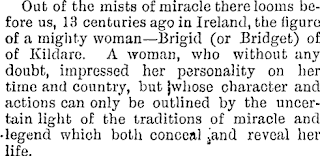Today to mark the feast of Saint Brigid of Kildare we can enjoy a nineteenth-century view of her which I came across in the Papers Past digital newspaper archive of the National Library of New Zealand. It is one of the many items relating to Irish saints which were syndicated from a worldwide variety of publications. This particular one from 1888 is attributed to The Woman's Suffrage Journal and it is fascinating to see the view of Ireland's patroness presented by this historic feminist source. For one thing, there is no mention whatever of a goddess, for it was only in 1880 that the Continental Celticist, Henri d'Arbois de Jubainville, first suggested that the saint had inherited some of the supposed attributes of a pagan deity. The anonymous writer of the piece below is happy to draw upon the traditional hagiography of Saint Brigid and to see the various supernatural events connected with her as evidence that she was no ordinary woman. Victorian feminism advocated for women to be allowed to exercise a positive moral influence on society and the writer is thus delighted by the stories which show Saint Brigid as someone whose opinion was sought by Bishops. Indeed, the writer feels that 'Brigid appears a type of all that is best in the character of the Irishwoman' before concluding with a short list of her virtues which she hopes 'the daughters of Erin' will long emulate. Wishing everyone the blessings of the Feast of our national patroness, Saint Brigid!
SAINT BRIDGET OF KILDARE.
Out of the mists of miracle there looms before us, 13 centuries ago in Ireland, the figure of a mighty woman — Brigid (or Bridget) of of Kildare. A woman, who without any doubt, impressed her personality on her time and country, but whose character and actions can only be outlined by the uncertain light of the traditions of miracle and legend which both conceal and. reveal her life.
Through the halo of these and many other legends which surround her, Brigid appears a type of all that is best in the character of the Irishwoman. We see her first as a bright, assiduous child, sharing all she has with the poor; then as an earnest girl, striving to fulfil her filial duties under difficult and complex conditions; finally as the self-sacrificing, devout woman, who felt that throughout all her life in all things she had the help of an angel of God while she spent her life for others, teaching and healing their quarrels as well as their diseases.
Whether a temporary and opportune blindness really came to her aid in the matter or not does not alter the fact that she overcame the plans her father had made for the marriage of his beautiful and attractive daughter and early devoted herself to a religious life.
Her birthplace was at Fochart, in County Louth, but her childhood and youth were, passed partly in the west, partly in the south. When her fame grew the inhabitants of Leinster besought her to return to them, and she, seeing in their wishes a divine call, fixed her place of abode under an oak which she much loved — the thenceforth famous Kildare (Church of the Oak), where in after years a holy fire was kept perpetually burning on her shrine. Then, during her life both a monastery and a nunnery grew up, under her rule, with one church in common. At Kildare she was buried, and thence, about 1185, her remains were translated to the tomb of St. Patrick and St. Columba, that the remains of Ireland's three greatest saints might rest side by side. There are churches to her honour in many lands, and many places have sought to be connected with her. She is said to have dwelt, for a time on the Isle of Man. Abernethy in Scotland, Glastonbury in England have claimed to be her place of burial, the fame of lesser Brides being absorbed in the light, of this greatest; Bride, Brigid, or Bridget,
Strong in affection, ready in pity, clear in judgment, bright in spirit — long may Brigid be the type of the daughters of Erin. — Woman's Suffrage Journal.
SAINT BRIDGET OF KILDARE. Otago Witness, Issue 1921, 14 September 1888.
Content Copyright © Trias Thaumaturga 2012-2022. All rights reserved.

No comments:
Post a Comment